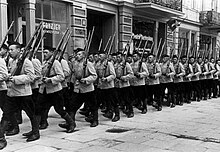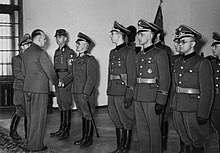
Nazi Germany used six extermination camps, also called death camps, or killing centers, in Central Europe during World War II to systematically murder over 2.7 million people – mostly Jews – in the Holocaust. The victims of death camps were primarily murdered by gassing, either in permanent installations constructed for this specific purpose, or by means of gas vans. The six extermination camps were Chełmno, Belzec, Sobibor, Treblinka, Majdanek and Auschwitz-Birkenau. Extermination through labour was also used at the Auschwitz and Majdanek death camps. Millions were also murdered in concentration camps, in the Aktion T4, or directly on site.
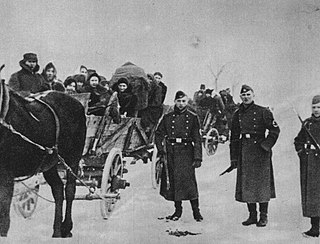
Belzec was a Nazi German extermination camp in occupied Poland. It was built by the SS for the purpose of implementing the secretive Operation Reinhard, the plan to murder all Polish Jews, a major part of the "Final Solution", the overall Nazi effort to complete the genocide of all European Jews. Before Germany's defeat put an end to this project more than six million Jews had been murdered in the Holocaust. The camp operated from 17 March 1942 to the end of June 1943. It was situated about 500 m (1,600 ft) south of the local railroad station of Bełżec, in the new Lublin District of the General Government territory of German-occupied Poland. The burning of exhumed corpses on five open-air grids and bone crushing continued until March 1943.
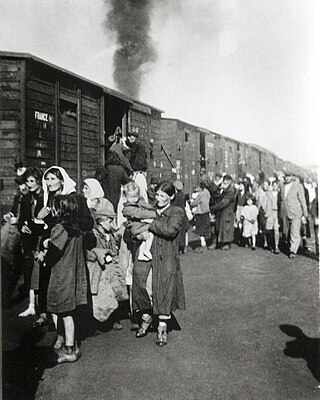
Operation Reinhard or Operation Reinhardt was the codename of the secret German plan in World War II to exterminate Polish Jews in the General Government district of German-occupied Poland. This deadliest phase of the Holocaust was marked by the introduction of extermination camps. The operation proceeded from March 1942 to November 1943; about 1.47 million or more Jews were murdered in just 100 days from late July to early November 1942, a rate which is approximately 83% higher than the commonly suggested figure for the kill rate in the Rwandan genocide. In the time frame of July to October 1942, the overall death toll, including all killings of Jews and not just Operation Reinhard, amounted to two million killed in those four months alone.

Hiwi, the German abbreviation of the word Hilfswilliger or, in English, auxiliary volunteer, designated, during World War II, a member of different kinds of voluntary auxiliary forces made up of recruits indigenous to the territories of Eastern Europe occupied by Nazi Germany. Adolf Hitler reluctantly agreed to allow recruitment of Soviet citizens in the Rear Areas during Operation Barbarossa. In a short period of time, many of them were moved to combat units.
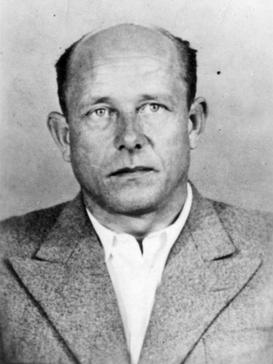
Hermann Julius Höfle, also Hans (or) Hermann Hoefle, was an Austrian-born SS commander and Holocaust perpetrator during the Nazi era. He was deputy to Odilo Globočnik in the Aktion Reinhard program, serving as his main deportation and extermination expert. Arrested in 1961 in connection with these crimes, Höfle died via suicide by hanging in prison before he was tried.
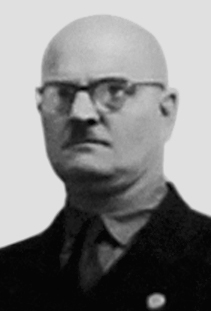
Christian Wirth was a German SS officer and leading Holocaust perpetrator who was one of the primary architects of the program to exterminate the Jewish people of Poland, known as Operation Reinhard. His nicknames included Christian the Cruel, Stuka, and The Wild Christian due to the extremity of his behaviour among the SS and Trawniki guards and to the camp inmates and victims.

Trawniki is a village in Świdnik County, Lublin Voivodeship, in eastern Poland. It is the seat of the present-day gmina called Gmina Trawniki. It lies approximately 24 kilometres (15 mi) south-east of Świdnik and 33 km (21 mi) south-east of the regional capital Lublin, and the river Wieprz flows by it.

The Trawniki concentration camp was set up by Nazi Germany in the village of Trawniki about 40 kilometres (25 mi) southeast of Lublin during the occupation of Poland in World War II. Throughout its existence the camp served a dual function. It was organized on the grounds of the former Polish sugar refinery of the Central Industrial Region, and subdivided into at least three distinct zones.

Feodor Fedorenko or Fyodor Federenko was a Soviet Nazi collaborator and war criminal who served at Treblinka extermination camp in German occupied Poland during World War II. As a former Soviet citizen admitted to the United States under a DPA visa (1949), Fedorenko became a naturalized U.S. citizen in 1970. He was discovered in 1977 and denaturalized in 1981. Subsequently, he was deported to the USSR, sentenced to death there for treason and participating in the Holocaust. Fedorenko was executed in 1987.
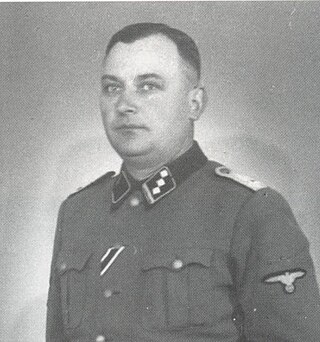
Richard Thomalla was a German war criminal and SS commander of Nazi Germany. A civil engineer by profession, he was head of the SS Central Building Administration at Lublin reservation in occupied Poland. Thomalla was in charge of construction for the Operation Reinhard death camps Bełżec, Sobibor and Treblinka during the Holocaust in Poland.

Siegfried Graetschus was a German SS functionary at the Sobibor extermination camp during Operation Reinhard, the deadliest phase of the Holocaust in occupied Poland. He was assassinated by a prisoner during the Sobibor uprising.
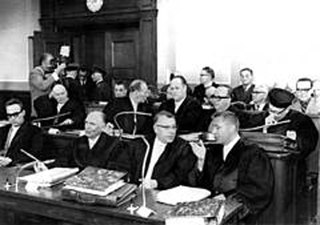
The Sobibor trial was a 1965–66 judicial trial in the West German prosecution of SS officers who had worked at Sobibor extermination camp; it was held in Hagen. It was one of a series of similar war crime trials held during the early and mid-1960s, such as the 1961 trial of Adolf Eichmann by Israel in Jerusalem, and the Frankfurt Auschwitz Trials of 1963–65, also held in West Germany. These trials heightened general public and international understanding of the extent of the crimes that had been perpetrated in occupied Poland some twenty years earlier by Nazi bureaucrats and persons acting as their executioners.
"Ivan the Terrible" is the nickname given to a notorious guard at the Treblinka extermination camp during the Holocaust. The moniker alluded to Ivan IV, also known as Ivan the Terrible, the infamous tsar of Russia. "Ivan the Terrible" gained international recognition following the 1986 John Demjanjuk case. By 1944, a cruel guard named "Ivan", sharing his distinct duties and extremely violent behavior with a guard named "Nicholas", was mentioned in survivor literature. Ukrainian–American John Demjanjuk was first accused of being Ivan the Terrible at the Treblinka concentration camp. Demjanjuk was found guilty of war crimes and was sentenced to death by hanging. Exculpatory material in the form of conflicting identifications from Soviet archives was subsequently released, identifying Ivan the Terrible as one Ivan Marchenko, leading the Supreme Court of Israel to acquit Demjanjuk in 1993 because of reasonable doubt. Demjanjuk was later extradited to Germany where he was convicted in 2011 of war crimes for having served at Sobibor extermination camp.
Poniatowa concentration camp in the town of Poniatowa in occupied Poland, 36 kilometres (22 mi) west of Lublin, was established by the SS in the latter half of 1941, initially to hold Soviet prisoners of war following Operation Barbarossa. By mid-1942, about 20,000 Soviet POWs had perished there from hunger, disease and executions. The camp was known at that time as the Stalag 359 Poniatowa. Afterwards, the Stammlager was redesigned and expanded as a concentration camp to provide slave labour supporting the German war effort, with workshops run by the SS Ostindustrie (Osti) on the grounds of the prewar Polish telecommunications equipment factory founded in the late 1930s. Poniatowa became part of the Majdanek concentration camp system of subcamps in the early autumn of 1943. The wholesale massacre of its mostly Jewish workforce took place during the Aktion Erntefest, thus concluding the Operation Reinhard in General Government.

Karl Streibel was the second and last commander of the Trawniki concentration camp – one of the subcamps of the KL Lublin system of Nazi concentration camps in occupied Poland during World War II.

During World War II, Trawniki men were Central and Eastern European Nazi collaborators, consisting of either volunteers or recruits from prisoner-of-war camps set up by Nazi Germany for Soviet Red Army soldiers captured in the border regions during Operation Barbarossa launched in June 1941. Thousands of these volunteers served in the General Government territory of German-occupied Poland until the end of World War II. Trawnikis belonged to a category of Hiwis, Nazi auxiliary forces recruited from native subjects serving in various jobs such as concentration camp guards.

Többens and Schultz was a Nazi German textile manufacturing conglomerate making German uniforms, socks and garments in the Warsaw Ghetto and elsewhere, during the occupation of Poland in World War II. It was owned and operated by two major war profiteers: Fritz Emil Schultz from Danzig, and a convicted war criminal, Walter C. Többens.
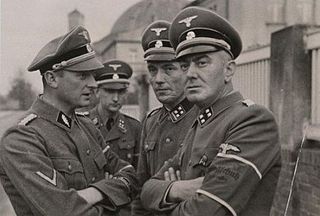
Ludolf Jakob von Alvensleben was a German SS-Standartenführer who during the Second World War served as a senior staff member of Operation Reinhard, by which Reichsführer-SS Heinrich Himmler planned to systematically murder the Jews of Europe. Alvensleben ended the war as the SS and Police Leader (SSPF) for Adria-West in Northern Italy/South Tyrol. He avoided prosecution after the war, but died in an automobile accident in 1953.
Georg Wilhelm Johannes Michalsen was a German SS-Sturmbannführer. During the Second World War, he was involved in the systematic deportation and murder of Polish Jews and later served as the SS and Police Leader in Trieste. Decades after the war, he was tried as an accomplice to murder, convicted and sentenced to twelve years in prison.

